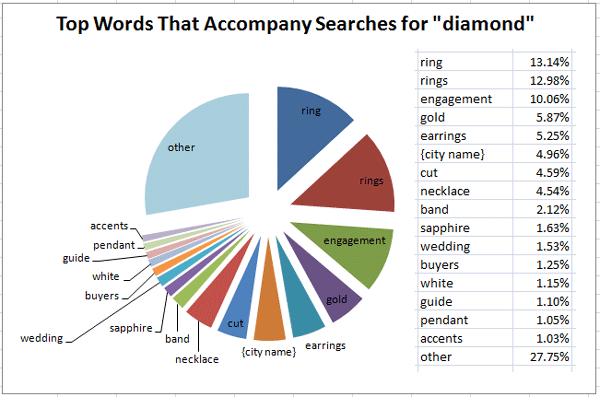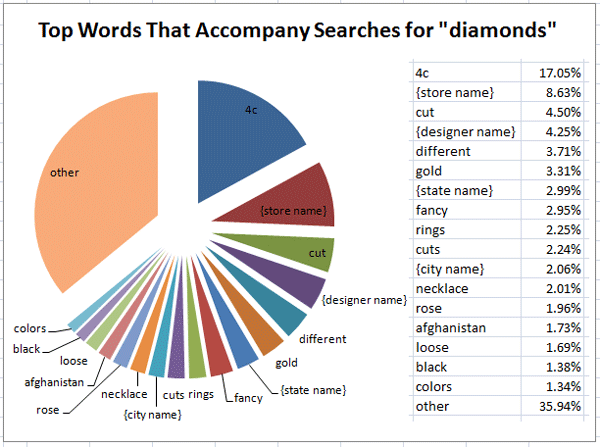
Today I'm reviewing more keyword data that I collected during the 2015 Holiday Season, specifically some of my findings about search queries that contained the words diamond and diamonds.
The typical keyword phrases I've reported on in the past have not changed much at all, and includes these examples:
- cushion cut diamond ring
- diamond engagement ring with sapphires
- white gold diamond rings
- diamond wedding ring
- diamond rings
In fact, I collected a few thousand keyword permutations during the holiday season, but I hesitate to continue to list these because doing so will perpetuate the old SEO approach of tweaking content for a single keyword phrase. Instead, this time around I've decided to organize my data differently and provide two set of keyword data that shows the most popular words that accompany searches for "diamond" and "diamonds."
Diamond Data
This pie chart shows the top 16 words that were included in queries for "diamond:"

The top accompanying word, with 13.14% of all search phrases, is "ring," as in the phrase "cushion cut diamond ring." The word "cut" also made it into this top list with 4.59% of all searches, and included phrases like "emerald cut," "old european cut," "brilliant cut," and "vintage cut."
The second most popular accompanying word, with 12.98% of all search phrases, is "rings," as in "white gold diamond rings." The word "gold" also made it into this top list with 5.87% and the word "white" made it into the list with 1.15% of search queries.
I organized all the searches for city names, state names, and specific store names into groups. As you can see in the above chart, search phrases that included city names accounted for 4.95% of "diamond" searches.
This is the list of the top 49 accompanying words:
- 13.14% ring
- 12.98% rings
- 10.06% engagement
- 5.87% gold
- 5.25% earrings
- 4.96% {city name}
- 4.59% cut
- 4.54% necklace
- 2.12% band
- 1.63% sapphire
- 1.53% wedding
- 1.25% buyers
- 1.15% white
- 1.10% guide
- 1.05% pendant
- 1.03% accents
- 0.93% black
- 0.92% solitaire
- 0.87% carat
- 0.87% heart
- 0.85% silver
- 0.72% jewelry
- 0.64% european
- 0.55% bands
- 0.50% stone
- 0.49% cocktail
- 0.49% pave
- 0.49% bracelet
- 0.46% karat
- 0.46% cross
- 0.45% guard
- 0.43% {store name}
- 0.42% hoop
- 0.42% pendants
- 0.41% dangle
- 0.38% grading
- 0.38% halo
- 0.37% grey
- 0.36% color
- 0.33% flower
- 0.31% stud
- 0.31% store
- 0.31% arrowhead
- 0.30% bezel
- 0.30% rosary
- 0.29% buyer
- 0.29% pearl
- 0.28% appraisal
- 0.27% fashion
- 11.89% other
Diamonds Data
This pie chart shows the top 17 words that were included in queries for "diamonds:"

When organizing the keyword data in this way, I was very surprised to see that searches for "4c" accounted for 17.05% of "diamonds" related searches, as in "4c of diamonds." This 4c group includes these permutations:
* 4c
* 4cs
* 4 c s
* 4 cs
* four cs
This data should be proof enough that every jewelry store needs to have an educational page explaining the 4cs of diamonds.
I was also very surprised to see that the retail store's name was the second most popular phrase to accompany searches for "diamonds." Examples include "{store name} diamonds" and "{store name} diamonds for sale." As a reminder, search queries that include store names are considered to be of the navigational search type, and usually performed by consumers that are already aware of a store. However, it seemed a little odd to me that someone would specifically search for "diamonds" along with a store name. Further investigation lead me to the discovery that the stores in this search group had older and poorly organized websites. It seems to me that consumers were using Google to help locate "diamonds" information on the sites.
This further reinforces the importance of website content organization that makes sense for the consumer and is easy to navigate.
I was also a little surprised to see how many specific designer names appeared in the search queries for "diamonds." I grouped all together as you see in the above chart. This further reinforced the need to include your designer names on your site.
In the above pie chart, you'll also notice groupings for {state name} and {city name}. These groups include specific city or town names, like "Totowa diamonds" and "New Jersey diamonds."
This is the list of the top 46 accompanying words:
- 17.05% 4c
- 8.63% {store name}
- 4.50% cut
- 4.25% {designer name}
- 3.71% different
- 3.31% gold
- 2.99% {state name}
- 2.95% fancy
- 2.25% rings
- 2.24% cuts
- 2.06% {city name}
- 2.01% necklace
- 1.96% rose
- 1.73% afghanistan
- 1.69% loose
- 1.38% black
- 1.34% colors
- 1.20% colored
- 1.10% types
- 1.05% creations
- 1.04% pearl
- 1.02% repurposed
- 1.01% buyers
- 0.96% sell
- 0.87% old
- 0.85% grey
- 0.85% european
- 0.79% engagement
- 0.79% afghan
- 0.76% bands
- 0.73% wedding
- 0.69% champagne
- 0.64% antwerp
- 0.61% mens
- 0.60% round
- 0.53% ring
- 0.53% pendants
- 0.49% jewelry
- 0.45% oval
- 0.42% tahitian
- 0.40% bracelets
- 0.37% passion
- 0.37% color
- 0.35% wholesale
- 0.32% shapes
- 0.30% brillliant
- 15.88% other
What To Do With This Information
You might think that a search intent for someone looking for "diamond" is the same as someone looking for "diamonds," but the above list of words should reveal that they are quite different. Clearly, if you want to attract these consumers you need to have content on your website that specifically targets each group.
Instead of worrying about specific keyword phrases, you should look at the above lists and build pages of content that include a few phrases that include these words next to the word "diamond" or "diamonds."








